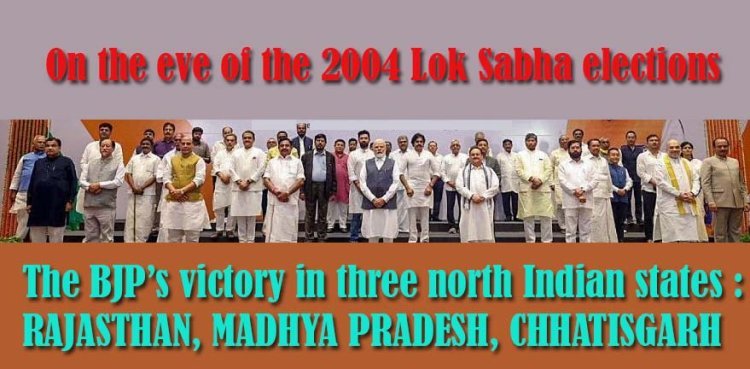Yogendra Yadav writes: For 2024, Opposition is still in the game
The next general election is not a done deal. Not yet. Unless the Opposition surrenders to this psychological warfare and gives a walkover before the match begins

On the eve of the 2004 Lok Sabha elections, I had written an article, ‘Never Mind the Pollsters, the Race is Still Open’ (The Hindu, March 15, 2004). It made a limited point: Notwithstanding the hype about “India Shining”, a dispassionate look at electoral numbers showed that a defeat for the BJP was a possibility. Something similar needs to be said now in the wake of the hype around BJP’s hat-trick in the three assembly elections: Never mind the darbari media, the race is still open.
Let me clarify what I am not saying. There is no doubt that the outcome in Madhya Pradesh, Rajasthan and Chhattisgarh is a setback for the Congress, and all those who wish to see restoration of democracy in 2024. The BJP’s victory in three north Indian states does overshadow the Congress’ historic comeback in Telangana. It creates favourable optics for the BJP in the run-up to the national polls. But this does not translate into cold numbers. The outcome of these four states does not change the electoral calculus as it stood before the results. I just don’t see how these reverses for the Opposition close the 2024 contest.
Let us start by counting votes. Before we conclude that a 3-1 victory for the BJP is a ringing endorsement of the regime by the voters, let us add up votes of both the leading parties for these states. Of the 12.29 crore votes polled, the BJP secured 4.82 crore, while the Congress had 4.92 crore (5.06 crore, if you include all INDIA parties). Except in MP, the margin of the BJP’s victory is very small in terms of popular votes. Congress’s lead over the BJP in Telangana is large enough to make up for its deficit in the rest. So the BJP has not received a massive popular endorsement in the latest round.
Let us convert these votes into parliamentary seats. We have a surprise in store. These states have 83 seats in the Lok Sabha, of which BJP had as many as 65 and Congress secured only 6 seats in the last Lok Sabha elections. Suppose the citizens of these states vote exactly the same way next year as they did in the recent assembly elections, the net gainer will be Congress, not the BJP. Even after this hat-trick, the BJP’s performance is way below its post-Pulwama support in 2019. If we add up assembly-wise votes for each parliamentary seat, the tally will be 24 for BJP and 5 for the Congress in Madhya Pradesh (compared to 28-1 in 2019), 8 for BJP and 3 for the Congress in Chhattisgarh (9-2 in 2019), 14 for BJP and 11 for Congress in Rajasthan (24-0 in 2019) and 0 for the BJP and 9 for the Congress in Telangana (4-3 in 2019). In all, it would mean 46 seats for the BJP (loss of 19) and 28 seats for the Congress (gain of 22). If we merge the votes of the INDIA partners, there would be 38 seats for the BJP and 36 for INDIA. I am not saying that this is the likely outcome. But this notional calculation puts to rest the idea that the BJP has sealed its victory.
Let us now consider the obvious argument that the Lok Sabha outcome may not replicate the Vidhan Sabha verdict. That’s true. We have seen a reversal in the BJP’s favour in 2019 and for the Congress in 2004. But this argument cuts both ways. If the BJP can look to improve upon its position in the next few months, so can the Congress. You can choose which of these scenarios is more likely, but the outcome of the recent elections is no basis to close any of these. The idea that the BJP is bound to improve its votes in the run-up to the national elections draws upon the misplaced parallel with 2019 when Balakot intervened between these two polls.
Let us for a moment assume that the BJP improves further during the next few months and sweeps the three Hindi states in the Lok Sabha just as it did last time. Assume further that this sweep extends to states like Gujarat, Delhi and Haryana. Does that settle the national contest? Not really, as the BJP had already reached saturation level in these states. A sweep here is necessary but not sufficient for the BJP. The Opposition’s game plan for 2024 is not dependent on these states.
Look at the big picture. In 2019, the BJP won 303 seats, just 30 seats above the majority mark. The BJP faces significant depletions in its unprecedented tally in Bengal (where it faces a meltdown), Karnataka (where, going by assembly election results for BJP-JDS combine, Congress would gain 10 seats), Maharashtra (where it faces the MVA), Bihar (pitted against a new Mahagathbandhan) and Uttar Pradesh (even a repeat of the 2022 Assembly results would mean a loss of 10 seats to BJP). Add to it near-certain but minor losses in Himachal Pradesh, Haryana, Telangana and Assam. Put any number to these losses for the BJP and it is sure to exceed 30. The hard question is: Where can the BJP possibly add to its 2019 tally and make up for these losses?
I am not saying that there is no way the BJP can contain its losses or make up for them. I am simply pointing to the writing on the wall, written in cold electoral numbers, as it stands today: 2024 is not a done deal. Not yet. Unless the Opposition surrenders to this psychological warfare and gives a walkover before the match begins.

















